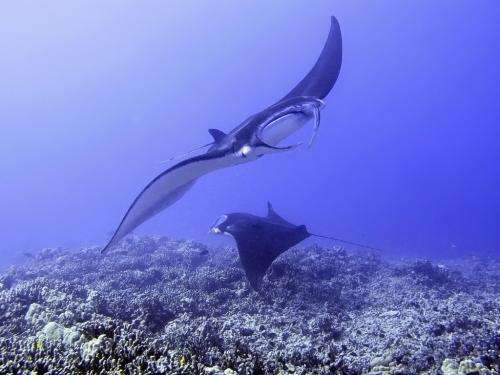Mangroves prove favoured hangout for young rays

Mangrove forests within the coastal lagoon of Mangrove Bay in Ningaloo Reef appear to be a key habitat for tropical rays during their vulnerable juvenile life-stage, a collaborative research project between Australian universities has found.
The study, led by Charles Darwin University expert Dr Florencia Cerutti-Pereyra sought to identify potential areas within Mangrove Bay, one of the northern-most sanctuary zones in the Ningaloo Marine Park off the Gascoyne, which tropical rays use as nursery areas.
"Many species of sharks and rays are known to use shallow bays as grounds where they give birth and their pups can grow," she says.
"Because of the world-wide fishing impacts on rays, and the fact that they can aggregate in large numbers in a very vulnerable stage of their life, identifying such areas is quite important for their protection and management."
Fifty-one acoustic telemetry receivers were deployed across the muddy lagoon neighbouring the mangrove forest (2m depth), in channels from the lagoon to the reef crest (10-15m depth) and in the open shelf (40m depth).
The researchers then spent 21 months analysing the movement and residency patterns of 16 juvenile rays from four different species tagged in 2008.
They found the shallow muddy lagoon habitat alongside the mangrove forest had the highest activity across all four species of juvenile rays over both study years¬—indicative of a nursery area.
"However, despite the concentration of activity here, juvenile rays do move through a larger area that goes beyond the sanctuary and beyond protected zones," Dr Cerutti-Pereyra says.
"This indicates that mangrove forests can potentially be key ecosystems for the development of tropical rays.
"Although the Mangrove Bay Sanctuary Zone does protect core areas of activity of juvenile rays, it fails to protect a larger range of their habitat.
"These results suggest that spatially-fixed management measures such as marine protected areas can protect key habitats and, in this case, core areas of activity of a vulnerable life-stage of rays, but may not be suitable for large marine animals which may have broader movement patterns."
Dr Cerutti-Pereyra recommends increasing the geographic area of monitoring across Ningaloo Reef to thoroughly study the ray's movement patterns.
She suggests overlapping this data with the marine park's boundaries to assess how effective the sanctuaries and protected zones are for the populations of tropical rays.
"Also using population genetics to study populations of these species across the park…[would provide] information on a longer time-scale, which may show if these populations that we see as 'isolated' actually overlap their ranges."
More information: "Restricted movements of juvenile rays in the lagoon of Ningaloo Reef, Western Australia – evidence for the existence of a nursery." F. Cerutti-Pereyra, M. Thums, C. M. Austin, C. J. A. Bradshaw, J. D. Stevens, R. C. Babcock, R. D. Pillans, M. G. Meekan Environmental Biology of Fishes. April 2014, Volume 97, Issue 4, pp 371-383. link.springer.com/article/10.1007%2Fs10641-013-0158-y
Provided by Science Network WA


















